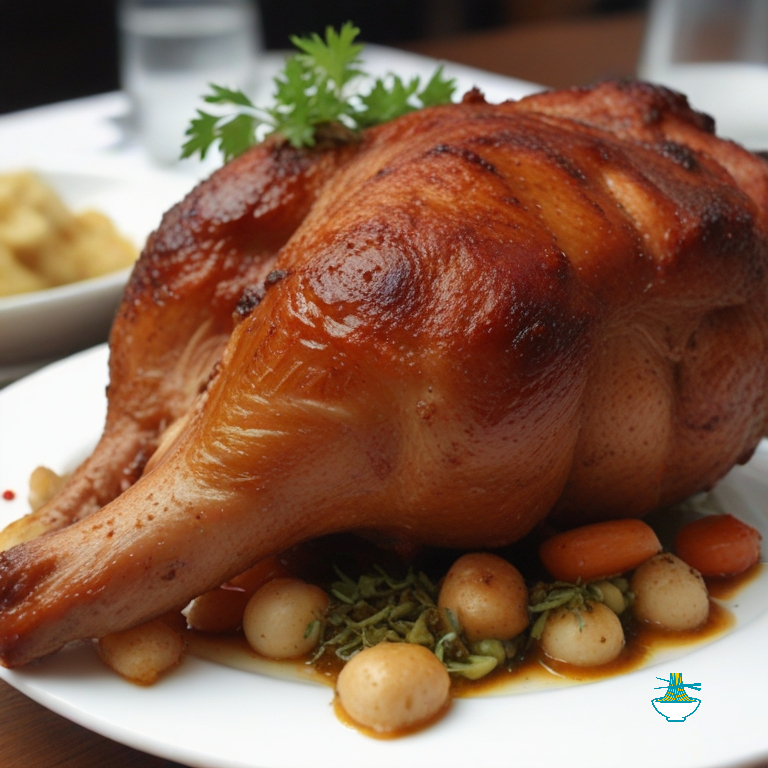Indulge in the epitome of German culinary tradition with Schweinshaxe, a mouthwatering dish renowned for its crispy, crackling exterior and tender, succulent meat within. Translating to "pig knuckle" or "pork hock," Schweinshaxe is a beloved German specialty that epitomizes the rich flavors and hearty fare of Bavarian cuisine.
Prepared by slow-roasting seasoned pork hocks until the skin achieves a delectable golden-brown crispness, Schweinshaxe offers a tantalizing combination of textures and flavors. Beneath its crunchy surface lies tender, juicy meat infused with aromatic spices and herbs, ensuring a culinary experience that delights the senses.
Served alongside traditional accompaniments such as sauerkraut, potato dumplings, or crispy roasted potatoes, Schweinshaxe embodies the essence of comfort food, perfect for savoring on festive occasions or cozy gatherings with loved ones. Whether enjoyed in a quaint Bavarian tavern or prepared at home with time-honored recipes, Schweinshaxe promises a gastronomic journey through the heart of Germany's culinary heritage.
Here's a traditional recipe for Schweinshaxe, also known as roasted pork knuckle:
Ingredients:
- 4 pork knuckles (approximately 1.5-2 kg each)
- 2 tablespoons caraway seeds
- 2 tablespoons coarse salt
- 2 teaspoons freshly ground black pepper
- 4 cloves garlic, minced
- 2 onions, sliced
- 2 bay leaves
- 2 cups chicken or beef broth
- 1/4 cup vegetable oil or lard
- 1/4 cup all-purpose flour
- Water, as needed

Instructions:
1- Preheat your oven to 180°C (350°F).
2- Rinse the pork knuckles under cold water and pat them dry with paper towels.
3- Using a sharp knife, score the skin of each knuckle in a crosshatch pattern, being careful not to cut too deep into the meat.
4- In a small bowl, mix together the caraway seeds, salt, black pepper, and minced garlic to make a spice rub.
5- Rub the spice mixture all over the pork knuckles, ensuring they are well coated. Let them sit at room temperature for about 30 minutes to allow the flavors to penetrate.
6- Heat the vegetable oil or lard in a large, oven-safe Dutch oven or roasting pan over medium-high heat. Once hot, add the sliced onions and bay leaves, and sauté until the onions are softened and lightly browned.
7- Push the onions to the side of the pan and add the pork knuckles, skin-side down. Sear them until the skin is golden and crispy, about 8-10 minutes per side.
8- Once the pork knuckles are nicely browned, pour the chicken or beef broth into the pan, covering the knuckles halfway. Cover the pan with a lid or aluminum foil.
9- Transfer the pan to the preheated oven and roast the pork knuckles for about 2.5 to 3 hours, or until the meat is tender and falling off the bone. Check occasionally and add more broth or water if the liquid evaporates too quickly.
10- Once the pork knuckles are cooked through, remove them from the oven and transfer them to a serving platter. Tent loosely with foil to keep warm.
11- To make the gravy, strain the cooking liquid from the pan into a saucepan, discarding the solids. Skim off any excess fat from the surface.
12- Place the saucepan over medium heat and bring the cooking liquid to a simmer. In a small bowl, mix the flour with a bit of water to make a slurry, then whisk it into the simmering liquid.
13- Continue to cook the gravy, stirring constantly, until it thickens to your desired consistency. Season with salt and pepper to taste.
14- Serve the roasted pork knuckles hot, accompanied by the gravy and your choice of side dishes such as sauerkraut, potato dumplings, or roasted potatoes.
Enjoy your authentic German Schweinshaxe!
Nutritional Values:
Providing precise nutritional values for ingredients can vary depending on factors such as brand, size, and specific cuts of meat. However, I can offer approximate nutritional information for some of the key ingredients commonly used in Schweinshaxe:
Pork Knuckle (per 100g):
- Calories: 240 kcal
- Protein: 18g
- Fat: 18g
- Carbohydrates: 0g
- Fiber: 0g
- Sugars: 0g
- Cholesterol: 70mg
- Sodium: 60mg
benefits:Pork knuckle is a good source of protein, providing essential amino acids necessary for muscle repair and growth. It also contains important minerals such as iron, zinc, and selenium, which support immune function and metabolism.
Vegetable Oil (per tablespoon):
- Calories: 120 kcal
- Protein: 0g
- Fat: 14g
- Carbohydrates: 0g
- Fiber: 0g
- Sugars: 0g
- Cholesterol: 0mg
- Sodium: 0mg
benefits:Vegetable oil, when used in moderation, can provide healthy unsaturated fats that are beneficial for heart health. It also contains vitamin E, an antioxidant that helps protect cells from damage caused by free radicals.
All-Purpose Flour (per cup):
- Calories: 455 kcal
- Protein: 12g
- Fat: 1g
- Carbohydrates: 95g
- Fiber: 3g
- Sugars: 0g
- Cholesterol: 0mg
- Sodium: 2mg
benefits:All-purpose flour serves as a versatile ingredient in cooking and baking. It provides carbohydrates, which are the body's primary source of energy. Additionally, it contains small amounts of protein and essential nutrients like iron and B vitamins.
Onions (per medium onion, approximately 110g):
- Calories: 44 kcal
- Protein: 1g
- Fat: 0g
- Carbohydrates: 10g
- Fiber: 2g
- Sugars: 5g
- Cholesterol: 0mg
- Sodium: 4mg
benefits:Onions are rich in antioxidants, particularly flavonoids and sulfur compounds, which have anti-inflammatory and immune-boosting properties. They also contain fiber, which promotes digestive health, and vitamin C, which supports the immune system and collagen production.
Please note that these values are approximate and can vary based on factors such as cooking methods, specific ingredients used, and portion sizes. Additionally, if you're following a specific diet or have dietary restrictions, it's always a good idea to double-check the nutritional information with the specific products you're using.


Comments